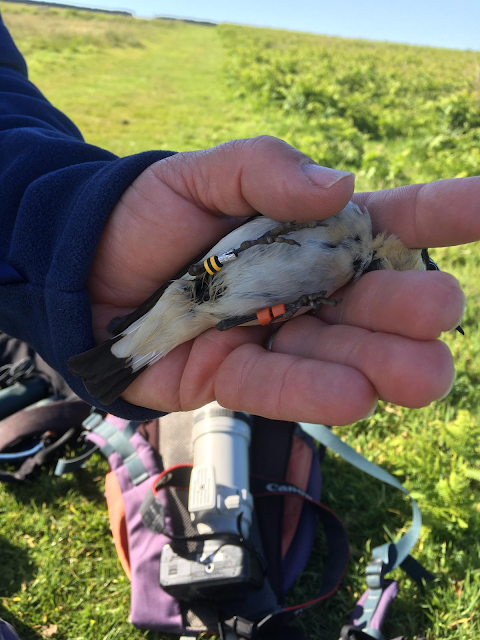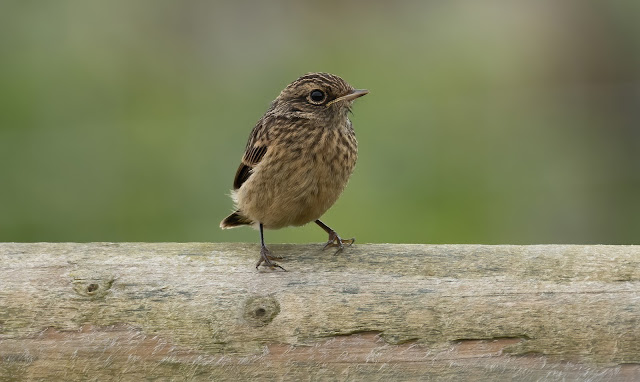25 April
Clear with strong easterly wind
A few common migrants were seen in Millcombe during the
morning census. Two Whitethroat were
seen, a Sedge Warbler was singing by Millcombe Pond and female Redstart was up by the Casbah. The
morning census continued up the track towards Old Light. A Chiffchaff was seen on the fence line by the gate at the burn site.
Further up the track a small warbler was seen flying strongly down the wall.
Fortunately it landed briefly on the wall so to see the bright white
underparts. The immediate thought was Bonelli’s Warbler. Some
record shots were taken before it flew over the other side of the wall and
despite a search appeared to have gone. Without hearing a call it is very
difficult to determine to species level.
But enough diagnostic features were seen to confirm it was one of these
rare migrants to the UK. Western Bonelli’s Warbler breed in Spain, Portugal,
France and Italy, whereas the Eastern Bonelli’s Warbler is found in Greece and
Turkey during summer.
 |
| Bonelli's Warbler, South West Field © Stuart Cossey |
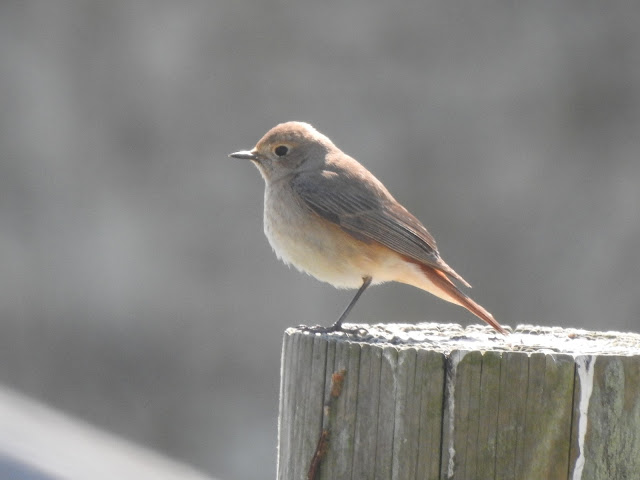 |
| Female Redstart, Millcombe © Stuart Cossey |
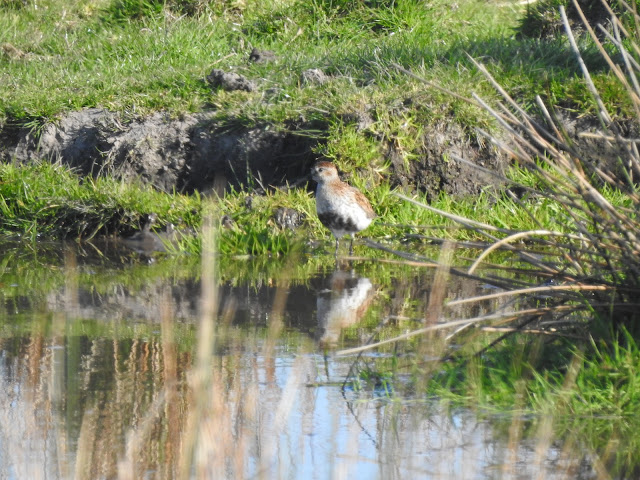 |
| Dunlin, Brick Field © Stuart Cossey |
Other birds of note were a Dunlin in the pond in Brick Field, a male Kestrel, a Grasshopper Warber and a male Ring Ouzel. The male Blue-headed Wagtail was
joined briefly by a Yellow Wagtail.
26 April
Continued strong easterly wind.
An unseasonal Treecreeper
was seen briefly in Millcombe along with a female Pied Flycatcher. Two Shelduck were then seen flying over
Benjamin’s Chair and were seen drifting east off the Rattles. From there until
Quarter Wall it was mainly Wheatear
and Skylark seen. Walking along
Quarter Wall an Eastern Subalpine Warbler hopped out of the
Brambles. It was a male with a lovely blue-grey back and brick red throat. It
was very flighty but was seen well on multiple occasions as it moved along the
wall between scrub and then moved off towards the Terrace.
 |
| Eastern Subalpine Warbler, Quarter Wall © Stuart Cossey |
 |
| Pied Flycatcher, Millcombe © Stuart Cossey |
Also seen were a male and female Redstart, the Blue-headed
Wagtail in Barton Field, a male Greenfinch
and two Grasshopper Warblers.
27 April
Warm and sunny with a moderate southeasterly
wind
The first Mallard Ducklings of the year were spotted
and a positively huge number of Wheatears
were seen all around the island, with 39 seen on the bird survey, and a total of
140 across the entire island. A Whimbrel
and two Swift were recorded along
with the 30 Sand Martin, 75 House Martin and 4200 Swallow zooming up both sides of the
island. Two Sedge Warblers joined the 10 Willow Warblers and 10 Chiffchaff along with 30 Blackcap and five Common Whitethroat and a
Pied Flycatcher. Birds of prey seen included a Kestrel and a Merlin. Two Whimbrel were seen by Tent Field.
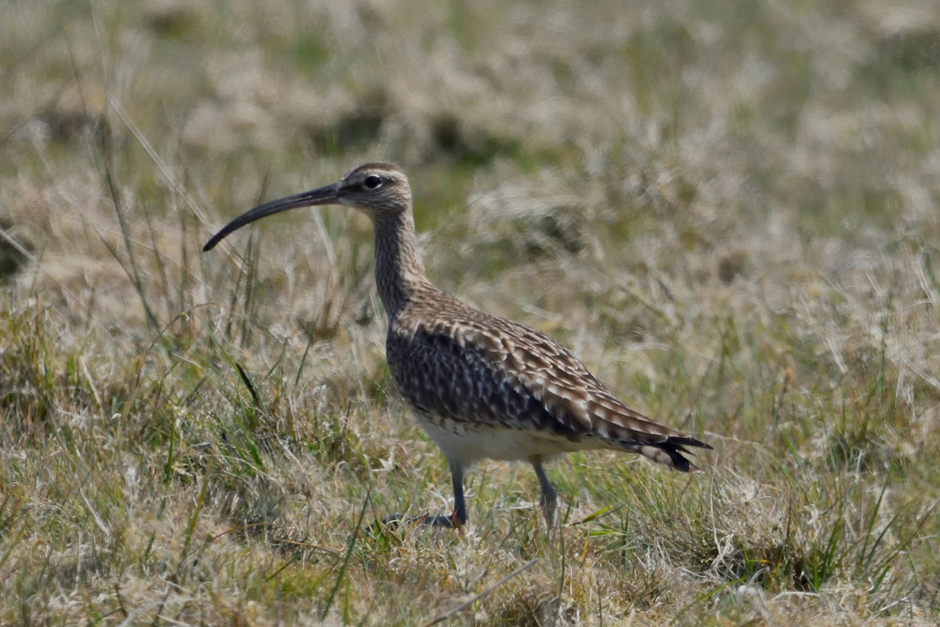 |
| Whimbrel, Tent Field © Laura Piratique |
In the
afternoon the warden team took a journey past Jenny’s Cove to Aztec bay to
check on the Kittiwake colonies to
be studied. A Ringed Plover was flushed off Middle Park on
the way. Nest building was making good progress in some cases and less so in others!
Fingers crossed for better productivity for the gulls this year, with 60
spotted at this site but no doubt more over the whole island.
 |
| Conservation team at Aztec Bay © Rosie Ellis |
The
highlight of the day was finding the first egg in one of the nest boxes at the
Old Light
Manx Shearwater colony.
After a
great afternoon with so much to look forward to, we were brought down to earth
with a bump with a sighting of a “Substantial rat” in the time keepers hut by a
concerned visitor [so far no concrete signs and RSPB have been to check]. The
biosecurity plan activated, interviews and the grid set up ensued. Many thanks
to all the team for setting up the grid before nightfall. A nervous evening
waiting for camera traps, ink traps and nibble marks to confirm or calm our
fears.
28 April
A strong cold breeze from the southeast.
A morning
survey showed relatively few birds, on the airfield most birds present were
huddled in the ditches and out of the way of the wind. The only exceptions were
the male wheatears, presumably to defend their turf from a would-be rival. A Water Rail was heard in the valley after a very quiet few weeks.
The camera
traps in the time keepers hut had revealed nothing yet and the surveillance
grid extended in the quarries area.
Visible
migration was much reduced with 3 Swift,
53 Swallow, 14 Sand Martin and five House Martin and one Lesser Whitethroat. The Merlin is still being seen on the island hunting Skylark.
A Puffin
survey at 11:30 revealed sixty three birds on the observed slope and 43 out on
the water of the cove.
Jenny’s Cove was surveyed, and yielded the
usual sightings of Puffin, Razorbill, Guillemot, Kittiwake and
Fulmar. A Peregrine was observed amidst the puffin burrows, possibly having
claimed a prey item. A few pairs of Wheatear
were displaying on the slopes of the cove.
29 April
A light wind from the east
Migration
picked up again with a Curlew heard
calling over the Church and a total of four Whimbrel. A Tree Pipit, Common Sandpiper and Lesser Whitethroat were seen. It
was a good day for ringing in Millcombe with 16 Sedge Warblers, a Garden Warbler and a Reed Warbler ringed. A swift was observed at
southwest point and a Sparrowhawk
was present. A Siskin was seen near
Brambles Villa.
The camera,
ink traps and monitoring stations all revealed nothing but ants, slugs and
Pygmy Shrews.
 |
| House Sparrow, Village © Zach Wait |
30 April
Overcast with a slight wind from the southeast
Morning
survey revealed a large array of birds, including a Peregrine, two Grasshopper
Warblers and a pair of Kestrels. 18+ Sand Martins were
observed and three were ringed in the nets at the Bramble accommodation. Approximately 150 Swallows were observed
throughout the day. A Ring Ouzel was also spotted in the morning
near Millcombe, and a Common Sandpiper was spotted near the landing
bay. A Hawfinch was noticed flying
over Millcombe valley. A Bar-tailed Godwit was seen at the Devil’s
Kitchen by Lundy ambassador Frances Stuart and at around 5pm, a Great Northern Diver was
sighted off the East Coast, near the Timekeeper’s Hut.
 |
| Sand Martin © Zach Wait |
Very
relieved with the arrival of Jaclyn Pearson from RSPBs biosecurity for life to
check our grid and for signs of rats. Eternal gratitude to Jaclyn, the
volunteers along with the Sparrow’s project’s Hope Belsham Clay, Meaghan
Kendall and the Boy’s Brigade for their help checking the grid for any signs of
rats, a fun evening spent checking bones, driftwood and plastic for any nibble
marks, with nothing found.
1 May
Rain and wind from the west
The morning
survey showed a variety of birds around the southern quarter, including a Whimbrel and two Lesser Whitethroats.
Other waders included a Curlew flying
over the Quarries. Four Gannets were
observed around the landing bay.
The first Cuckoo of the season was sighted around
Millcombe. A Reed Warbler was ringed
and a Tree Pipit heard flying over. A Harbour
Porpoise was seen off the jetty.
Thankfully there is still no sign of a rat.
Many Thanks
to Rob Duncan and for their sightings,
enthusiasm demonstrations and talks for visiting university group and visitors,
Jamie Dunning for his help with the morning census, birder’s ear and rhododendron
searching and all the boy’s brigade for their help and
understanding with the biosecurity monitoring.



